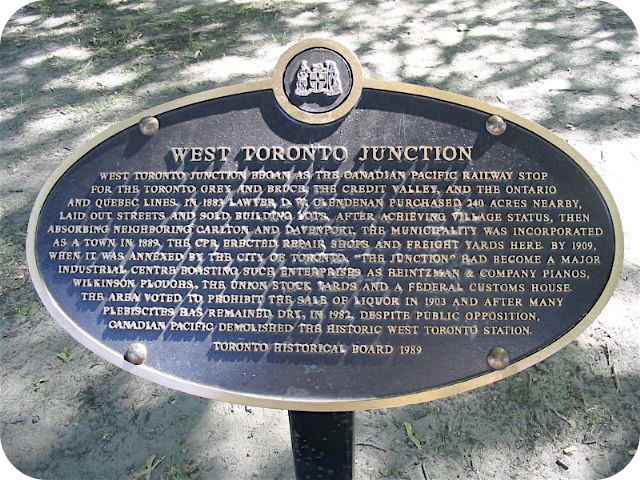Discover Toronto's history as told through its plaques
2004 - Now in our 15th Year - 2019
To see what's new on this site, you can visit the Home Page
Looking at this page on a smartphone?
For best viewing, hold your phone in Landscape mode (Horizontal)
West Toronto Junction

Photos by Alan L Brown - Posted September, 2006

On the east side of a park at Keele Street and Humberside Avenue you will find this 1989 Toronto Historical Board plaque. A copy of this plaque can also be found just inside the front doors of the Annette Street branch of the Toronto Public Library on Annette Street at Medland Avenue, 2 blocks west of Keele Street. Here's what it says:
Coordinates: 43.662412 -79.462346 |
 |
West Toronto Junction began as the Canadian Pacific Railway stop for the Toronto Grey and Bruce, The Credit Valley, and The Ontario and Quebec Lines. In 1883 lawyer D.W. Clendenan purchased 100 ha nearby, laid out streets and sold building lots. After achieving village status, then absorbing neighbouring Carlton and Davenport, the municipality was incorporated as a Town in 1889. The CPR erected repair shops and freight yards here. By 1909, when it was annexed by the City of Toronto, "The Junction" had become a major industrial centre boasting such enterprises as Heintzman & Company Pianos, Wilkinson Ploughs, the Union Stock Yards and a Federal Customs House. The area voted to prohibit the sale of liquor in 1903 and after many plebiscites has remained dry. In 1982, despite public opposition, Canadian Pacific demolished the historic West Toronto Station.
Related webpages
West Toronto Junction
Toronto Junction
The Junction
Canadian Pacific Railway
Carleton
Davenport
West Toronto Station
Related Toronto plaques
West Toronto Junction
Early History and Evolution of the Junction
Theodore August Heintzman 1817-1899
Ontario Stock Yards
Related Ontario plaques
Toronto, Grey and Bruce Railway
More
Neighbourhoods, Villages and Towns
Here are the visitors' comments for this page.
> Posted November 21, 2018
I am descended from:
Richard Bond (1812-1873) and Ann Bond (1810-1877), great-great grandparents.
John Stephenson Bond (1845-1919) and Rebecca Davis (1855-1925), great grandparents.
Frank Jennings Bond (1896-1977) and Katie Jean Powell (1902-1985), grandparents.
John Francis Bond (Jack), (1930-2015) and Doreen Margaret Patterson (1930-), parents.
In 1993, a cousin of my dad, also named Jack, told me that my great-grandfather, (John S. Bond), had been Mayor of West Toronto Junction. Jack Bond also told me that John S. Bond had owned land where the bridge by the Old Mill crosses the Humber River. As a result, John S. collected tolls from travellers using the bridge. The toll bridge story seems rather tall to me. I haven't been able to find any references to tolls on this bridge, but given there has been a crossing since 1837, I am sure tolls may have been collected at some time.
I thought also, that the Mayor of West Toronto Junction story was a bit tall, but it turned out to be true, except that it was John Stephenson's brother James, (1840-1906,) who was Mayor of West Toronto Junction in 1894-1895.
It appears James was a bit of a raconteur, as he reportedly closed a manufacturing business in Toronto, to pursue land opportunities in the developing Junction.
Census records have him starting out as a labourer at age 21, but by 1891, he is listed as an estate broker. Local history also has him running a butcher shop on Dundas Street at one point. He then managed to parlay his political connections with the Whitney government into a job as a liquor license inspector! While performing these duties, he was struck and killed instantly by a streetcar in 1906.
Given that John S. Bond was a wagon maker, and his brother James was a "going concern", I am guessing, if there is any truth to the toll bridge story, that it applies to James, rather than my great-grandfather, John S. Bond.
David Bond [email protected]
> Posted April 25, 2010
Hello. Your text refers to the CPR station being demolition in 1982 but the link connects to a photograph of the CNR station in West Toronto. [Editor's Response: Thanks. Link is fixed.]
> Posted June 16, 2009
Baird Park, at Keele and Humberside, is the park where you found the plaque and I believe the Junction has not been "dry" since sometime in the 1990's. Cheers!
> Posted February 19, 2009
I will never understand why anyone would want to tear down the old railway stations? And rip up all the old lines? Out with the old, in with the new is not always the best way to be.
Here's where you can send me a comment for this page.
Note: Your email address will be posted at the end of your comment so others can respond to you unless you request otherwise.
Note: Comments are moderated. Yours will appear on this page within 24 hours (usually much sooner).
Note: As soon as I have posted your comment, a reply to your email will be sent informing you.
To send me your comment, click [email protected].
Thanks
Webmaster
Note: If you wish to send me a personal email, click here.